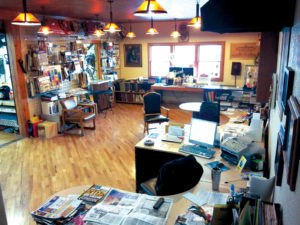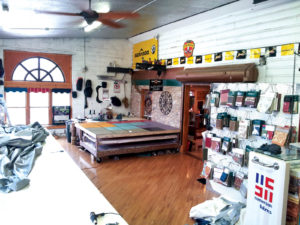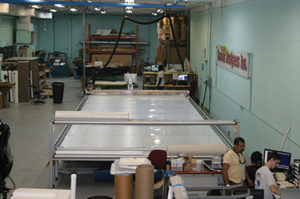Creating a dream shop

Larry Schneider’s Milwaukee-based Homestyle Custom Upholstery shop, which began in his parents basement, now features 1,000 square feet of office space alone.
Steve Jobs started Apple in his parents’ garage. Amazon, Google, Hewlett-Packard, Mattel and Microsoft also began in garages. Dell and Facebook began in dorm rooms. And Virgin Group’s humble beginnings trace back to an old church crypt.
Like Jobs, Larry Schneider founded a company in his parents’ house—though in the basement. The owner of Homestyle Custom Upholstery in Milwaukee, Wis., started an automotive upholstery business at the age of 17 in 1973 (a few years before Jobs founded Apple). He also worked at a few auto-trim shops and an upholstery factory making bags and tents.
“I learned efficient sewing techniques before being hired by a marine store to open a boat canvas and upholstery shop,” Schneider recalls. “I worked there for 3½ years and learned that I loved to work on boats. That’s when I opened my first shop in 1983 in Oak Creek, Wis. I was there for 26 years until the landlord died and the family sold it to a developer. I moved to a 4,000-square-foot shop. Two years into my three-year lease, I knew I had to own my own property. The rent was eating me alive, and I was too far from the water. I rehabbed a blighted building near downtown Milwaukee in Bayview near five marinas and boat-storage yards.”
Schneider opened his business with five sewing machines and five employees. Today he has 10 sewing machines, six employees, a bender, a crowner and a welder.
“We are in my dream shop right now,” he says.
Also following that humble-beginnings pattern, Mike Erickson founded Canvas Designers in 1985 on his back patio with a used Adler lockstitch, walking-foot sewing machine and one employee. Today, his company has 42 employees, 27 sewing machines, a hot-wedge machine, an RF welder, a cutter/plotter, an automated CNC machine and 27,500 square feet of shop, office and showroom space in Riviera Beach, Fla. Erickson even owns the 35,000-square-foot building housing his business and leases the space he doesn’t currently need.
In 1996, Mike Johnson started Mike’s Marine Canvas in Virginia Beach, Va., in his garage with a Juki sewing machine, an 8-by-7-foot table and a few hand tools.
“Cordless drills just came out 17 years ago, which helped a lot out on the boats,” Johnson says. “Also, getting a shop finally [in 1998] and then a second sewing machine was a big help.”
Mike Bennett began Bennett Custom Canvas of Toronto, Ontario, in the bedroom of a house he was renting “with a bunch of friends” and started booking orders for the coming season before he even had a shop.
“I was walking out on a limb,” he admits.
After four months of booking orders in the off season, Bennett moved into a 1,600-square-foot space that served not only as his shop but also as his residence for two years. He still has his shop there, but now lives in an apartment above it.
It’s not just size that matters

Schneider’s expanded office space also features a project showroom.
While size might matter in boats, shop square footage—in and of itself—is not necessarily the holy grail. “Larger” considerations include convenience for the shop and its customers, an efficient layout and a workable operation for the shop owner and employees.
“I love my shop,” Bennett says. “I love being able to go downstairs and work when I want.”
His first piece of equipment was an industrial sewing machine that failed to be the right fit for his business. He subsequently purchased three Reliable sewing machines, a Crownarc bender and a Bendarc wall bender, but he says the equipment that has made the biggest impact on his business is a foam cutter that allows him to explore more opportunities in upholstery. And he credits his decision early on to put all his cutting tables and equipment on casters as a wise decision.
“If I need a certain amount of space, I can change the configuration of my shop,” Bennett says. He’s begun “building up” with shelving, and he loves having a 500-square-foot showroom. “Customers can go through material samples,” he says. “And we have won a few awards, so they’re put up on the walls.”
Albeit better than a patio, Canvas Designers’ first shop—moved into six months after the business began—was a mere 1,000 square feet.
“Then we grew to 2,500 square feet four or five years later,” Erickson says. “Another four or five years later, we went to 15,000 square feet—all broken up. Then five years later—I tend to have a five-year itch, I think—we moved into 15,000 square feet. It was a parallel move [in square footage], but it was a larger warehouse with high ceilings and open room—a more efficient layout. Then I purchased the 35,000-square-foot building and moved into 27,500 square feet of it.”
The shop that has scratched Erickson’s most recent five-year itch is divided into interconnected 5,000-square-foot bays. One is dedicated to machining metal, welding and sealing. The next is filled with sewing machines and tables for the canvas operation, then the RF welder and heat sealer. The next bay houses the offices, lunchroom, showroom and fitters’ room for patterning. Next comes a bay for foam fabrication, upholstery sewing and stapling. A 5,000-square-foot, longer and narrower bay running along the back of those areas houses
the technology used in multiple operations.
“The last 2,500 square feet is called, in humor around here, ‘the man cave,’” Erickson says. “It’s where I keep my personal tools and shop and some of my own toy projects and where customers’ boats come in.”
About eight years ago, Tom Matson and Greg Smith started a canvas shop owned by a marina in Afton, Minn. Afton Marina & Yacht Club has three sewing machines, a hot-wedge vinyl welder and a tubing bender.
“We have a pretty decent-sized shop,” Matson says. “And if we are working on big enclosures, we have three machines and a third person we can pull in for repairs. Our sewing area is 60 feet by 120 feet, and there’s a huge service bay behind us to pull boats into.
“We actually have a dream shop. I am sitting here overlooking the St. Croix River. Aesthetically, it’s one of the best shops I have been in. And because we are employed by the marina, we can use their services.”
Johnson moved into his current shop in 2003. Mike’s Marine Canvas is “right down the street” from three marinas, he says, “so it is very convenient and a big time saver. In addition, there are several other marinas within 20 to 30 minutes. That’s a big reason we stay where we are.”
Jay Hanks started Allerton Harbor Canvas in Hull, Mass., in 2004 with a Juki straight-stitch, walking-foot sewing machine. Today, he has two more Juki sewing machines, a bender, a crowner, three employees and a 1,500-square-foot shop.
“We are in a fairly new building, which we set up four years ago with equipment we had or knew we were getting,” Hanks says. “We planned it so we would have a staging area for the bending-frame setup and more table space.
“The thing I like about my shop is that I am right on the water, so people can come to the marina and I can work on their boats while they’re here,” he says.
Seth Hetherington started Mobile Marine Canvas in Harpswell, Maine, in 1994 with a Consew walking-foot sewing machine, then bought two more Consews. Today he has two employees. He dedicates 75 percent of his 3,500-square-foot shop to tables for canvas assembly. Another 20 percent is used for tube bending and welding and the remainder for Hetherington’s office.
“Our shop is two floors, both 25 by 40 feet,” he says. “We also have a building—22 by 40 with 120-foot ceilings—to put boats into.”
Schneider bought a circa-1890 building to house his upholstery business, which includes a 2,000-square-foot barn into which he can pull boats, a 1,000-square-foot “breakdown room” with five work stations and room for two vehicles or boats, a 3,000-square-foot sewing room and a 1,000-square-foot office and showroom area.
“We also have a warehouse where we keep spare sewing machines,” he adds.
The shop at Mike’s Marine Canvas is 16 feet wide by 70 feet long; the office and showroom take up the front 11 feet.

Canvas Designers’ 35,000-square-foot shop in Riviera Beach, Fla., is divided into 5,000-square-foot sections designed to meet specific equipment/processing needs.
“Go through the door and there is a rolling table, 8 feet by 8 feet, that one can walk around for trimming patterns or finishing curtains and receiving repairs, freight, etc.,” Johnson says. “Then the shop is filled with a table that is 8 feet by 26 feet to one side with just enough room to walk past on the right. On the left is another walkway, but with 2 feet by 12 feet of storage bins of fabric rolls standing up, then two sets of 18-by-48-inch Gorilla shelves and another set of shelves 12 inches by 48 inches.
“The sewing machines are placed about 3 feet from each end of the long table, one on the left, one on the right, with about 8 feet by 8 feet between the two. That way, two people can sew curtains at the same time without interfering in the other’s space. At the back end of the shop are eight cardboard shipping tubes for 40-gauge vinyl tubes, cut in half, standing on end in a 2-by-4-tube pattern. We use them to store full and partial sheets of vinyl during production and after.
“Every square inch of wall space has 12-inch shelving, and several have 8-foot pieces of PVC track on the bottom, in eight rows, in order to slide completed curtains as we finish them. That’s 64 feet of track—enough for two large enclosures.”
What customers want
Canvas-shop owners have their ideas and ideals about their operations, but what their clients consider essential is critical, as well.
“Overwhelmingly, the most important thing is attention to detail and dialog with the customer,” says Peter Deri, manager of SkipperBud’s—Milwaukee marina and a client of Homestyle Custom Upholstery. “By attention to detail, I mean the seam lines are straight, there’s not an excess of material used, there’s not an excess of backside flap. And, also, the canvas shop stands above and beyond the rest by being able to adapt to almost any situation—any request within reason.
“The other thing is that if it’s good, a canvas shop offers options in materials and color,” he says. “The size of the shop has to be adequate to meet our needs. Ultimately, we expect them to have adequate machinery and manpower. How they get there is up to them. I am concerned mostly with the finished product.”
Mike Hebert of Marshfield, Mass., and a customer of Allerton Harbor Canvas, looks for timeliness and quality service at a reasonable price.
“It helps if the shop is local, as I will give local vendors the first look both for convenience … and to help others in my community,” he says. “So location is important, but not everything. I believe the appearance of the shop and its employees is a clear indication of whether or not the work will be done on time and in a quality manner. Obviously, a quality shop will be busy; but if it looks like an episode of Hoarders, with everything strewn about in disarray or if the employees take notes about your requests on the back of their takeout lunch bags, that’s usually a deal-breaker for me …. In order, I would rank reputation absolutely first, followed by location, appearance, size, equipment and number of employees.”
Another Allerton customer, Bill Schmid, points out that he doesn’t own a 65-foot, custom-built racer that may command the attention of many canvas shop owners. “Can you do something with my 30-foot, 5-year-old, leech-line sailboat and not make me feel unworthy?” he posits. But that’s just one question. Schmid offers a thoughtful laundry list:
“Is the shop in proximity to the water? Does it feel like it is part of the maritime activities that surround it? Can you see where the work is done and get a look at those people ‘behind the curtain’ who will be toiling over your precious sail and canvas? Is the shop involved in the community that supports it? Does the shop have an open and amiable ambiance? Is there somewhere in the shop that touts the work that has been done and reflects the current satisfied customer base that has contributed to the shop’s success?
“Of course, you have to know the shop is capable of handling the jobs that you require,” Schmid continues. “This confidence will come less from a technical inventory of equipment and assessment of the girth of the operation than from the reputation the shop has acquired and the feeling of trust and confidence that is conveyed when you meet the proprietor.
“So, if the shop has the right feel and I can meet the person who is running the shop and he assures me he has the requisite talent, experience and correct tools to get the job done in a timely manner at a reasonable price, then we move forward.”
Another Allerton customer, Ray Kasperowicz, also wants a connection with the owner.
“The most important thing I look for is the likelihood that I can personally work with the owner and his people and that they are responsive,” says the owner of a 40-foot sailboat. “A neat shop, well laid out, obviously reinforces the feeling that I’m dealing with an effective and efficient operation.”
Tony Tobias, sales manager for the Erickson Marine boat dealership in Hastings, Minn., takes all his canvas jobs up the St. Croix River to Afton Marina. “We work with several different manufacturers, and most of our boats come with canvas from the factory,” he says. “A lot of customers want a full enclosure. Rather than go back to the manufacturer, it’s easier to go to Afton Marina.”
While location is a major consideration for Tobias, he also looks “for somebody who can get something done in a timely manner.” His list of criteria is simple: location, price, quality and timeliness. Not so important is how the shop is equipped.
“I am in the boat-selling business. I wouldn’t know a sewing machine from a punch press,” he says. “To me, it’s the end result and the price.”
Smooth sailing
Regardless of the amount of square footage they have under a roof, wise shop owners find ways to keep their businesses running like a well-oiled machine.
As the name Mobile Marine Canvas suggests, Hetherington offers off-site services, carrying a tube bender to locations in his van. “We go to the site and install frames and patterns, then go back to the shop to sew them,” he says. “We custom designed and manufactured a tube bender that allows us to do the frames, and I built my own tube crowner. My design system is adjustable to any width, can bend right and left in one step and can make repetitive frames for production orders very accurately.”
Canvas Designers has converted from clutch/belt/pulley systems to electronic servo motors. “That was a big changeover,” Erickson says. “It helped quality and operator control of the machine.” He considers many elements critical to a well-run shop.
“My priority would be equipment first,” he says. “Second would be processing and flow. Location—you want to be near enough to your customer base, but you don’t have to be right on the water as a canvas shop. Size, to get an efficient layout, I find to be really important. Size was important for our growth. Our tables are large; we want big areas.”
Moving from 15,000 “broken up” square feet to 15,000 open square feet, Erickson notes, “made a huge difference in our productivity. We could create a better flow for manufacturing the products we make.”
Janice Kleinschmidt is a freelance writer from San Diego, Calif.
 TEXTILES.ORG
TEXTILES.ORG 






